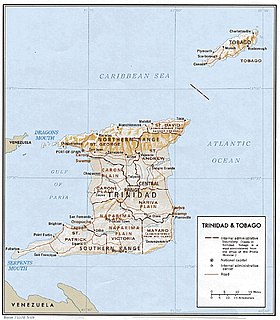Southern Range

On the island of
Central Range is the Naparima Plain;[1] the lowland area on the east is the Nariva Plain. The Oropuche River flows through the Naparima Plain and drains into the Oropuche Lagoon, a swampy area, on the Gulf of Paria coast, whereas the 31-mile long Ortoire River flows through the Nariva Plain and drains into the Nariva Swamp on the Atlantic Ocean coast.[1] The Southern region of the island has sandy and less fertile soil.[1] The Southern Range, particularly its Western and Central parts, consists of unconsolidated segments.[2]
The
Red brocket deer and the elusive Ocelot
can be seen here. The Lagon Bouffe mud volcano, one of Trinidad's largest mud volcanos is located here.
Trinity Hills is the highest point in the Southern Range, at 325 meters.[3]
Notes
- ^ a b c d e Black 1976.
- ^ Kenny, J. S. The Biological Diversity of Trinidad and Tobago: A Naturalist's Notes. Trinidad and Tobago: Prospect Press, 2008. p. 204
- ^ Kenny, Julian S. Views from the Ridge: Exploring the Natural History of Trinidad and Tobago. Port of Spain: Prospect Press, 2000. p. 13
References
- Black, Jan Knippers (1976), Area handbook for Trinidad and Tobago, American University (Washington, D.C.). Foreign Area Studies, Supt. of Docs., U.S. Govt. Print. Off., retrieved 14 October 2013
